Southern Cross Wildlife Care Critters of the Month - 2013
Meet Lewis - the blue-tongue lizard - April 2013 - By Lynleigh Grieg
Blue-tongue lizards are a wonderful addition to any backyard. They are not at all dangerous to humans or pets and they are extremely useful too. They help by eating the snails, slugs and caterpillars that attack your favourite plants.
The only problem about blue-tongue lizards is that they often look like a fun play-mate to a dog. But a dog’s mouth is a very dangerous place for a lizard’s head to be... This is how we met and came to love Lewis.
Lewis was bitten on the head by a dog in somebody’s backyard in Dee Why. The bite was so bad that his front head plates collapsed and put pressure on his brain. As a result, he was unable to walk and was in danger of dying. As soon as we got him, we injected him with medication that reduces swelling on the brain and we started him on antibiotics immediately.

We took him to renowned volunteer wildlife vet, Dr Howard Ralph, and Lewis was immediately put under anaesthetic for his procedure. His head plates had to be realigned to relieve the pressure on his brain and three pins were inserted to prevent those front plates from sinking again.
 He was bandaged up and allowed to ‘hang’ with some of our other patients: 4 very mischievous baby blue-tongue lizards and Charlie, who was recovering from a cat-attack.
He was bandaged up and allowed to ‘hang’ with some of our other patients: 4 very mischievous baby blue-tongue lizards and Charlie, who was recovering from a cat-attack.
 Lewis and baby Meridah became very good mates during his recuperation.
Lewis and baby Meridah became very good mates during his recuperation.
Every day we would give him some physiotherapy and hydrotherapy under nice warm water.
Six weeks after his accident, he took his first steps! It was incredible and wonderful and miraculous. It was almost as exciting as the day my children learnt to walk for the first time! We clapped and cheered for him and he did look very pleased with himself :)
 Lewis had several follow-up consultations with Dr Ralph. Being a reptile, his progress was a little slower than it would be in, say, a mammal.
Lewis had several follow-up consultations with Dr Ralph. Being a reptile, his progress was a little slower than it would be in, say, a mammal.
This photo shows how well the pins allowed his head scales to align.
And now Lewis is happy again. He’s so precious. The day of his release will be very momentous and joyous (and sad).
Lewis’ Adoptive Mum, Sydney Wildlife

Be blue-tongue lizard-friendly by:
Leaving rocks for blue-tongues to use as shelter. Plant low-growing shrubs so lizards can move safely around your yard. Keep a watchful eye on your dog or cat if they go near where blue-tongues live.
Southern Cross Wildlife Care - May 2013 Critters of the Month - Theodore and Blossom - Orphaned babies- By Lynleigh Grieg
Ringtail possums are - in my opinion - one of the cutest Australian animals! They are smaller than brushtail possums and have a long prehensile tail with a distinctive white section near the tip. They eat native foliage, native flowers and fruit. They are marsupials because they carry their young in pouches.
 Meet Theodore (left) and Blossom (below) - “Outta my way, I want the camera to capture my good side...!”
Meet Theodore (left) and Blossom (below) - “Outta my way, I want the camera to capture my good side...!”
These two adorable ringtail babies came into care with Sydney Wildlife in February of this year. Theodore came riding into someone’s house, clinging to the neck of their dog! His mum was never found. Blossom’s mum was killed by a cat.
They were both about 65 grams when they came into care. At this weight, the babies require around-the-clock care! 4-hourly feeds day and night and artificial heat. They are put into little woollen pouches, lined with cotton fabric inserts. These mimic their mum’s pouch. The babies are always ‘buddied’ together with others of similar weights.
 Theodore has always been very ‘clingy’. He never wanted to let go of me after his feeds and refused to go back into his basket...! You can see his little claws wrapped tightly around my fingers.
Theodore has always been very ‘clingy’. He never wanted to let go of me after his feeds and refused to go back into his basket...! You can see his little claws wrapped tightly around my fingers.
Blossom, on the other hand, was happy to be popped back into her knitted pouch and cuddle up in her favourite fluffy blanket. I think the ‘fur’ reminded her of her mum...
As the babies get bigger and bigger, they graduate from pouches to something called a ‘drey’. Ringtails build these  dreys or nests in the wild using all sorts of twigs, foliage and grasses. These babies will eventually be released into the wild in their drey. As they grow, they are also moved from a tiny basket to a big cage and eventually into an outdoor aviary.
dreys or nests in the wild using all sorts of twigs, foliage and grasses. These babies will eventually be released into the wild in their drey. As they grow, they are also moved from a tiny basket to a big cage and eventually into an outdoor aviary.
Blossom and Theodore have been growing week by week and are now big enough to be in a big outdoor aviary. As soon as they are able to lap their milk independently, we carers become completely ‘hands-off’. Their milk, foliage and fruit  is placed into the aviary whilst they are asleep during the day. This de-humanises them and teaches them not to rely on us for their survival.
is placed into the aviary whilst they are asleep during the day. This de-humanises them and teaches them not to rely on us for their survival.
Theodore and Blossom are likely to be released in a few weeks’ time.
If you would like to keep our wonderful ringtails safe, please remember:
1. keep your cats indoors at night
2. drive very carefully at night in case they are on the road
3. try not to spray poisonous substances on your native plants
Critter of the Month - June 2013
Saving George- By Lynleigh Grieg
Late one Thursday night, I was called to a snake rescue in Frenchs Forest. The caller was unsure of the type of snake as it was so tangled up in fruit netting that it was unrecognisable.
 I bundled the kids into the car and bolted down the Wakehurst Parkway. The snake was down the side of the house in the dark. By torch-light we managed to get him into a bag. At this stage it was still too dark to identify the type of snake, but whatever he was, he was in a lot of trouble...
I bundled the kids into the car and bolted down the Wakehurst Parkway. The snake was down the side of the house in the dark. By torch-light we managed to get him into a bag. At this stage it was still too dark to identify the type of snake, but whatever he was, he was in a lot of trouble...
 By this stage it was around 10pm and we needed help to untangle this little guy. I knew Jodi (another wildlife carer) would be up for the challenge so we headed straight to her place. When we arrived, her dining table had been transformed into a surgery. She had clean drapes on the table, towels, blunt-ended scissors for cutting through the netting without harming the scales and lots of Betadine.
By this stage it was around 10pm and we needed help to untangle this little guy. I knew Jodi (another wildlife carer) would be up for the challenge so we headed straight to her place. When we arrived, her dining table had been transformed into a surgery. She had clean drapes on the table, towels, blunt-ended scissors for cutting through the netting without harming the scales and lots of Betadine.
In the light we could see he was a harmless little Green Tree Snake - whew! That made things easier... George.
George was in a very bad state. We began to slice through the netting as quickly as possible as it was literally cutting through his skin and getting tighter with every move he made. It took us an hour and a half but George was the perfect gentleman throughout the harrowing procedure.
 After the netting was finally all removed, we bathed him in Betadine. At nearly midnight, the children and I drove home with poor George. That night, I popped him into a tank on a heat-mat and sang him the ‘good night’ song that I sing to my kids, thinking that he would not be with us by morning...
After the netting was finally all removed, we bathed him in Betadine. At nearly midnight, the children and I drove home with poor George. That night, I popped him into a tank on a heat-mat and sang him the ‘good night’ song that I sing to my kids, thinking that he would not be with us by morning...
But to our delight, his beautiful, curious little face was staring up at us the next morning from his tank!
We rushed him up to see Dr Howard Ralph - a renowned veterinary surgeon with plenty of experience in treating snakes.
George was put under anaesthetic while we investigated the damage. Dead scales and skin was removed and Dr Ralph gave him sub-cutaneous fluids as he was very dehydrated. He was bathed again and bandaged up.
 I had to give poor George oral antibiotics twice a day for a week which he didn’t really like but he never tried to bite me. In fact he never even hissed at me, no matter how many injections I gave him or how many times I changed his bandages.
I had to give poor George oral antibiotics twice a day for a week which he didn’t really like but he never tried to bite me. In fact he never even hissed at me, no matter how many injections I gave him or how many times I changed his bandages.
Whilst he was recuperating, we discovered that George liked to listen to the guitar. Many people argue that snakes don’t really hear but George always responded when my husband played the guitar. We tried all sorts of other instruments, but the only one that made him come out of his cave and ‘dance’ was the guitar!
 In this picture, I had just assisted him in shedding his skin. It was very tricky for him because of all the lacerations to his body. We sat out on the balcony together and he just lay quietly in my lap while I picked off the shed, scale by scale. It took 2 hours. I chatted, he listened. I sang, he listened. I chatted some more, he listened. He’s a very good listener :)
In this picture, I had just assisted him in shedding his skin. It was very tricky for him because of all the lacerations to his body. We sat out on the balcony together and he just lay quietly in my lap while I picked off the shed, scale by scale. It took 2 hours. I chatted, he listened. I sang, he listened. I chatted some more, he listened. He’s a very good listener :)
After we’d finished, I smothered him in a special wound-healing cream and popped him back to bed.
 In this picture, he was coming along nicely and looking very shiny after his Betadine bath.
In this picture, he was coming along nicely and looking very shiny after his Betadine bath.
The problem with Green Tree Snakes is that they seldom eat when placed in captivity. Given that George was with us for almost 12 weeks, we had to ensure that he ate. We force-fed him through a crop-needle.
My kids, Connor and Kayleigh, grew very fond of George during his recuperation period. He had regular check-ups with Dr Howard Ralph and he was always very well-behaved (George, not Dr Ralph ha ha).
 After 12 weeks of injections, baths, bandages, force-feeding and guitar-playing, George was ready to go back to the wild.
After 12 weeks of injections, baths, bandages, force-feeding and guitar-playing, George was ready to go back to the wild.
In this photo (below), Kayleigh is giving him one last cuddle before his release. He went back to the place where he’d been found which was his territory before the “accident”. The family that had called us to the rescue had kept up with his progress for the entire 12 weeks. They were very anxious to have him back in their backyard.
 Look how healthy he looks in this photo!
Look how healthy he looks in this photo!
We released him in a gorgeous place, just metres from the garden where he’d been found.
It was a very sad Good Bye. George had slithered his way into all our hearts...!

Southern Cross Wildlife Care - Critter of the Month - July 2013
Fuzzy Little Wilbur By Lynleigh Grieg
Say hello to Wilbur, the Brushtail Possum.
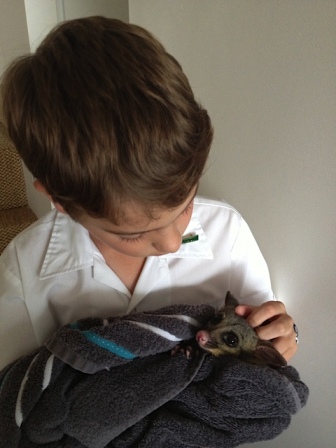
Wilbur was placed into care and hand-raised from the weight of 150g. Right from the start, his carer began to notice that he was having mini-seizures - possibly as a result of head trauma from the impact of the car. As he grew, his seizures became more frequent and his vision seemed impaired, so his carer brought him to us.
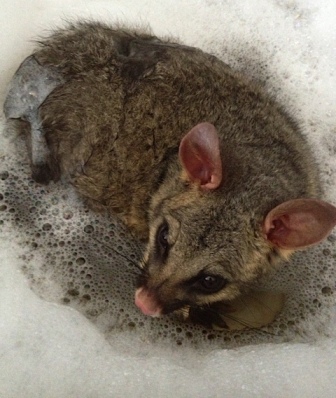
We popped him into a warm Betadine bath and towel-dried him in front of the fire before he got to see the doc :)
He enjoyed it thoroughly, but kept trying to eat the bubbles!
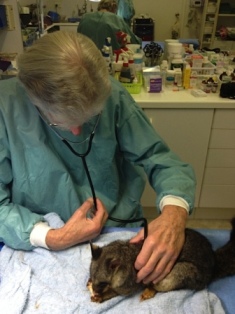 Dr Ralph examined Wilbur (who was being entertained with a piece of banana) to see what could be done. They had a chat about life in general and Wilbur was sent home with various medications to help prevent his seizures. Now - we just need to keep up with his treatment and see what happens...
Dr Ralph examined Wilbur (who was being entertained with a piece of banana) to see what could be done. They had a chat about life in general and Wilbur was sent home with various medications to help prevent his seizures. Now - we just need to keep up with his treatment and see what happens...
Well, Wilbur now has a weekly bath as it’s his favourite thing to do. After we bath him and drain away the water, we say “Shake, shake, Wilbur!” and he shakes off the water obediently - it’s so sweet.
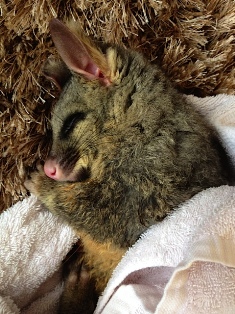
Brush-tailed possums are marsupials, and their young are usually born around May/June after a gestation period (pregnancy period) of just 17 days. The newborn possum crawls its way into the mother's pouch and attaches itself to a teat.
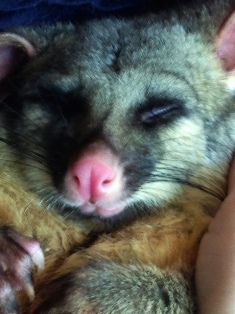
They are fully grown by about 10 months’ old.
Wilbur is such a sweet boy. We’re holding thumbs for you, little man.
Southern Cross Wildlife Care - Critter of the Month - August 2013
Whipper's Journey - The Tale of No Tail...
By Lynleigh Greig
On a balmy May afternoon, this beautiful Blue-tongue lizard was hiding in the long grass, minding his own business probably just waiting for a juicy snail to amble by... All of a sudden a loud noise ripped through the serenity and the blade of a whipper-snipper came bearing down on him. With no time to react, the poor little guy found himself without his glorious tail and a searing pain tearing through his body...
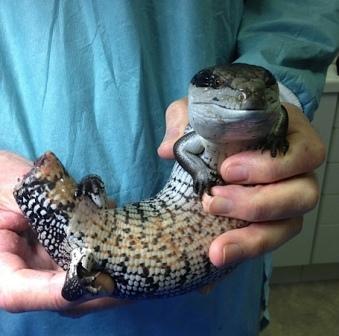
Thankfully the person operating the whipper-snipper realised the gravity of his situation and rushed him to a local vet.
Sydney Wildlife carer, Jodi, picked him up the following day. She aptly named him “Whipper”...
Whipper was whisked up to Dr Howard Ralph - a veterinary surgeon now specialising in wildlife. Whipper was put under General Anaesthetic straight away. With part of his bone exposed, Dr Ralph knew the wound would never heal. The bone was cut back, the dead cells curetted and a dressing applied.
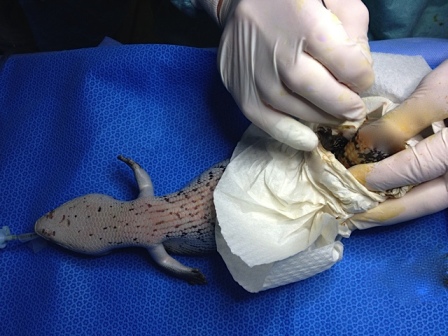
Whipper underwent intensive daily treatment for his tail. He had to have daily Betadine baths and fresh dressings applied, as well as antibiotic injections to prevent infection.
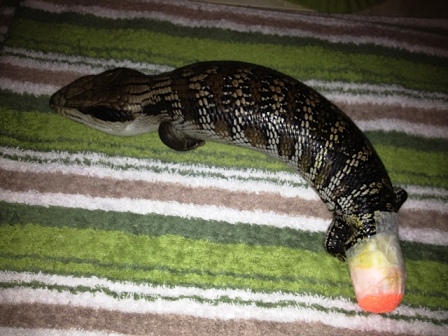
Poor little darling looked like he was wearing a nappy...
Time for your check-up... Alright, Whipper, say “Ahhhhhhhh”
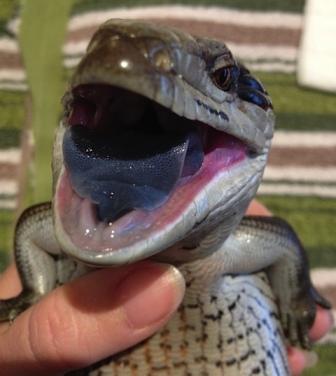
Despite all the pain he had to undergo on a daily basis, Whipper was a perfect gentleman throughout the rigorous procedure.
And he never lost his sense of humour (or appetite...!)
After 3 months, Whipper’s tail is looking mighty fine! He may be missing his glorious tail, but he’s still such a handsome fellow :)
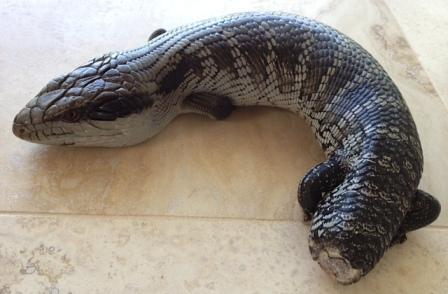
Now, Whipper - stay away from gardening equipment...!
The Moral of the Story is:
Before you mow your lawn or whipper-snip your edges, please check the grass for these friendly little reptiles.
Southern Cross Wildlife Care - Critter of the Month - September 2013
Baby Water Dragon
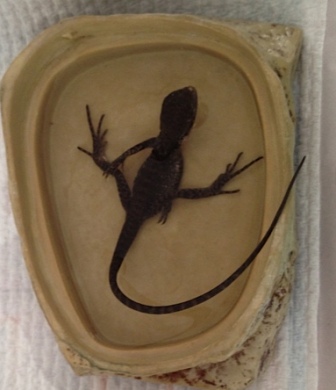 In January of this year, a baby water dragon was found in Chatswood running around awkwardly in someone’s backyard. The home owner noticed he wasn’t using his front legs correctly, picked him up and took him to a local vet.
In January of this year, a baby water dragon was found in Chatswood running around awkwardly in someone’s backyard. The home owner noticed he wasn’t using his front legs correctly, picked him up and took him to a local vet. He was then passed on to us.
This is Greville. All 4 grams of him!
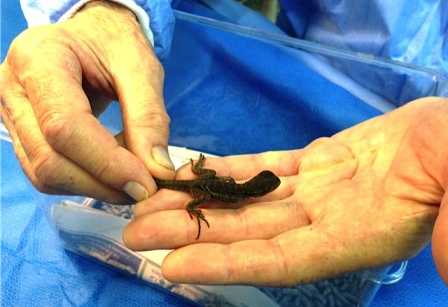
Dr Howard Ralph examined him. He was convinced Greville was suffering from a cervical injury and took him down to the clinic in Braidwood for an X-ray. Sure enough, the X-ray showed a neck injury and so began Greville’s 8-months of physiotherapy...
You can see from this photograph that he was just folding his front legs behind him.
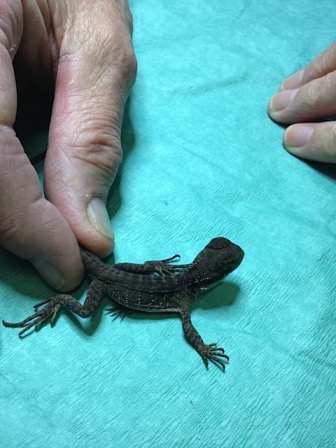
We had to train his front legs to move, to bend and to hold him upright. We used hydrotherapy as well. This was undertaken daily.
For company, Greville shared accommodation with a pair of baby Bearded Dragons. They became very good friends and all cuddled together on a log at bedtime. They also shared mealtimes: crickets, mealworms and veggies. Yum...
As the months went by, Greville began to get the feeling back into his tiny front legs and his muscles began to build up again. We were so pleased with his progress! Once or twice he managed to wriggle free and have a run...! Water dragons are quite tricky to catch...
After 8 months of daily treatment, Greville was ready to face the world again. We took him to a gorgeous area with an abundance of insects for mealtimes, lots of water and plenty of undergrowth in which to hide.
This photo shows him looking to his new and brighter future.
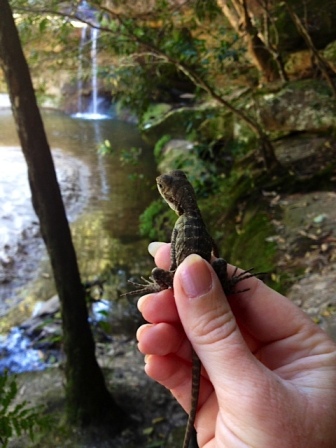
Good luck, little man!
Southern Cross Wildlife Care - Critter of the Month - October 2013
Rescue of a hit and run victim
Late one night a swamp wallaby was bounding through the bush alongside Mona Vale Rd. Wishng to cross to the other side, he jumped into the road and collided with the side of a car. Sadly, the driver of that car did not stop. Thankfully, however, a kind man by the name of Matt saw the poor animal get hit and stopped immediately. He picked up the adult wallaby, wrapped it in a drop-sheet and drove all the way to SASH animal hospital in Ryde to get veterinary attention for the animal.
The wallaby was x-rayed and had a full examination. He was found to have head trauma, nystagmus (vision impairment – possibly as a result of the head trauma) and was poorly ambulatory. He was treated with the necessary medication and allowed to rest.
The next morning he was very quiet but did respond slowly to noise. He still had minimal response to light, indicating possible blindness.
The vets wanted the wallaby to have a few days’ rest to ascertain whether or not the blindness was a temporary symptom of the concussion. A volunteer carer from Sydney Wildlife collected him that night and transferred him to their Macropod Rehabilitation Facility in Duffy’s Forest. The wallaby was set up in the quarantine room. The poor thing just sat in the corner of the room with his head bowed.
The next morning, however, he seemed able to hop around, unsteadily, and his sight appeared to be slowly returning. Over the next few days, he began to hop around in the outside enclosure without bumping into obstacles.
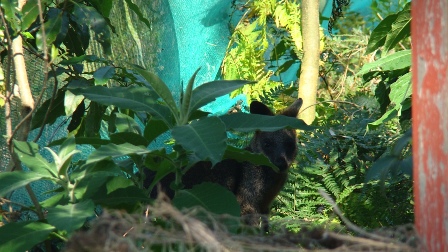
Within one week he was back to being a normal wild swamp wallaby - thumping his feet on the ground as a warning if your approach was too close before taking off at great speed around the enclosure.
It was decided that he could now be released back into the wild and hopefully would go on to live a long and carefree life.
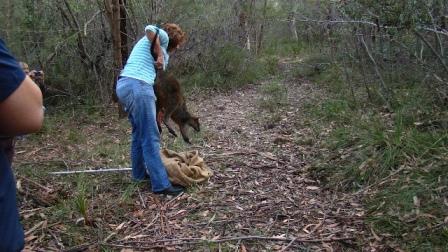
On the Northern Beaches we are very lucky to have these magnificent creatures at our doorstep. Please drive carefully and if you do accidentally hit an animal on the road, please stop and check if it requires help. If the animal is a marsupial (an animal with a pouch) and is dead, it’s really important to check the pouch for live young. If you cannot take the animal to a vet please ring Sydney Wildlife on 9413 4300.
Story by Joan Reid
Southern Cross Wildlife Care - Critter of the Month - November 2013
Wombat Woes
Here are some facts about wombats:
• They are native only to Australia.
• They are marsupials.
• They eat mainly grasses and roots.
• They live in large burrows up to 30 metres long.
• The average wombat is about 1 metre long and weighs about 25 - 30kg.
• The mums have a pouch with a backward-facing opening so that when they dig, the baby doesn’t get covered in dirt!
This adorable baby wombat came into care after his Mum was killed by a car. Little Splinter was in his Mum’s pouch at the time of impact. His pelvis was squashed in the accident and - as a result - his urethra was compromised. He was rushed to Dr Howard Ralph and treated immediately.
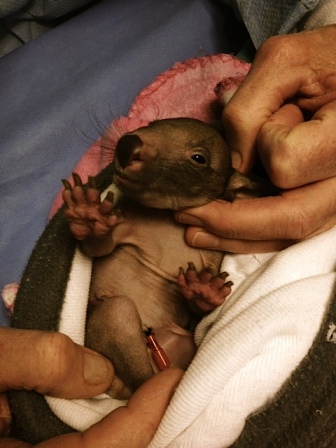
Splinter was unable to pass urine through a crushed urethra so a suprapubic catheter had to be inserted. You can see it in this photo.
He’s still on 4-hourly feeds so he’s very reliant on his wonderful carers. When you put your finger on his paw, he curls his tiny clawed digits around your finger and holds you tightly. It’s very endearing!
Little Splinter will require ongoing care and quite a number of visits to Dr Ralph, but we are confident that he will be able to recover.
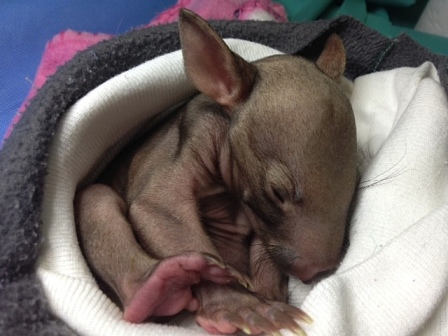
Isn’t he sweet?
__________________________________
Southern Cross Wildlife Care - Critter of the Month - December 2013 - curated by Lynleigh Greig
Kevin - Very Dishy, but Somewhat Fishy...
Ever wondered what it would be like to venture out at midnight on a Friday night to capture a wild and injured pelican...? Well, Sonja Elwood of Sydney Metropolitan Wildlife Services had the dubious honour of undertaking such an ordeal last Friday...
There must’ve been many people that drove past poor Kevin the Pelican, but only one was kind enough to stop and make a call to wildlife rescuers about his plight.
Sonja happened to be working the ‘After-hours Hotline’ at Sydney Wildlife when she received the call. Getting there quickly was imperative, so she and Tyson were on the scene just after midnight, equipped with lots of towels, an extra-large carrier/enclosure and plenty of courage.
Pelicans don’t like to be watched, so you have to sidle up to them with your eyes averted and attempt to capture them ! whilst looking away... Not an easy task! After some side-stepping and fox-trotting, Tyson managed to get a blanket over Kevin’s head and bundled him into the carrier. Phew!
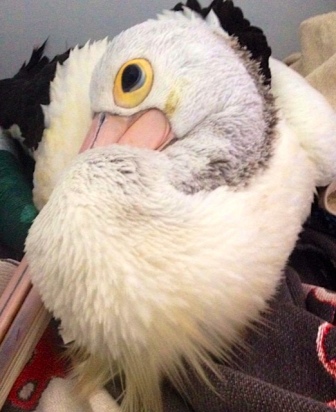
Food for Kevin was going to be a bit of a problem at that time of the morning so a quick stop at the servo for some bait was in order. Mmmmmm squid for breakfast...!
Nobody’s exactly sure how Kevin sustained his wing injury, but it was evident that he’d been suffering for quite some time.
An emergency trip to Dr Howard Ralph, veterinary surgeon atSouthern Cross Wildlife Care, was in order.
Dr Ralph put Kevin under General Anaesthetic to take a closer look at that nasty injury. He cleaned and debrided the wound, applied dressings and gave antibiotic cover. Luckily there were no fractures.
He was given fluids to address any dehydration issues.
When he had recovered from his procedure, Kevin received some counselling from Dr Ralph.
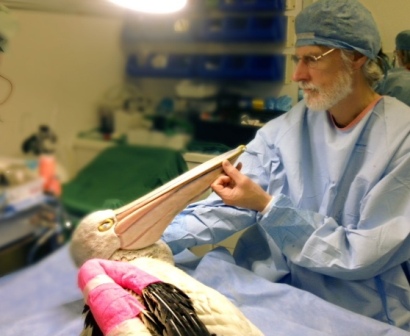
Kevin was a perfect gentleman. Until he decided to regurgitate the contents of his stomach onto the operating table...! Followed in quick succession by a full evacuation of his bowel...! Thank you, Kevin. As if the smell of fishy breath wasn’t enough... :)
The team fell madly in love with Kevin. Such a dear little fellow. Lindy found him truly quite charming.
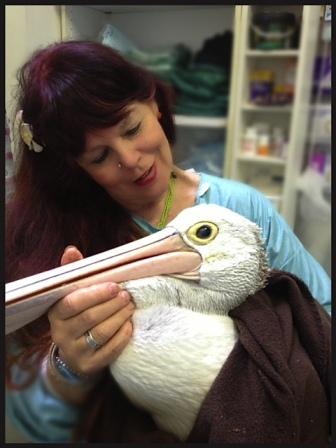
Back home, Sonja made a little nest for Kevin in the laundry and filled a little paddling pool out in the courtyard.
The team at Southern Cross Wildlife Care feel very privileged to be able to help Kevin. His wing will need regular dressing changes and he will require ongoing antibiotic cover but his chances of full recovery are very high.
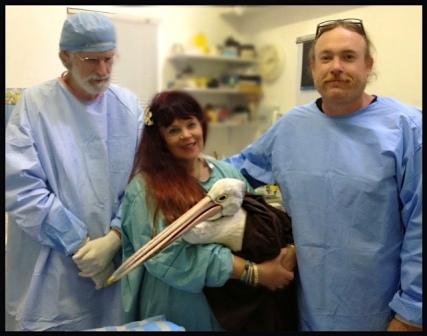
Good luck, Big Kev!